Welcome to our comprehensive guide on Nymphaea Tiger Lotus, a stunning aquatic plant that adds elegance and beauty to any freshwater aquarium or aquatic garden.
In this article, we will delve into this captivating plant’s history, care, propagation, and integration, providing you with the knowledge you need to cultivate and appreciate its unique charm.
Whether you are an experienced aquatic gardener or a beginner, understanding the growth requirements and plant care tips for Nymphaea Tiger Lotus is essential.
From planting techniques to nutrient management, lighting needs, and successful propagation methods, we will cover it all.
Dive in and discover the secrets to cultivating and maintaining the beauty of Nymphaea Tiger Lotus in your own aquatic environment.
Key Takeaway
- Nymphaea Tiger Lotus is a striking aquatic plant that enhances the beauty of freshwater aquariums and aquatic gardens.
- Understanding its history, native habitat, and visual appeal provides a deeper appreciation for this elegant plant.
- Proper planting techniques, nutrient requirements, and lighting needs are essential for successful cultivation.
- Learn the various propagation methods to expand your collection of Nymphaea Tiger Lotus.
- Integrating Tiger Lotus into a home freshwater aquarium requires careful consideration of compatible plants and fish.
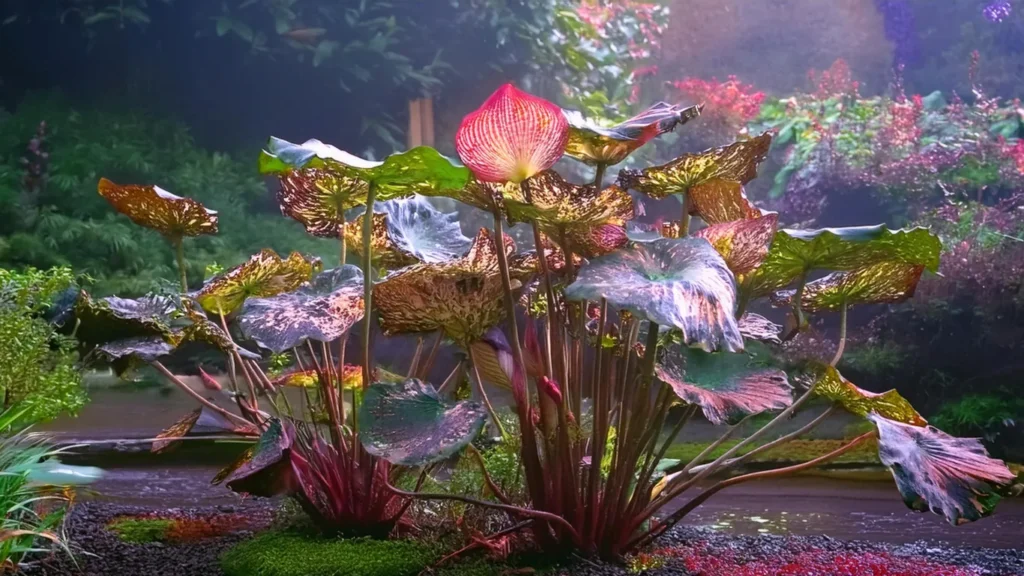
Quick Stats
| Attribute | Details |
| Family Name | Nymphaeaceae |
| Origin | Africa, Southeast Asia |
| Height | 10-50 cm (4-20 inches), depending on variety and conditions |
| pH Range | 6.0 – 7.5 |
| CO2 Requirement | Low to Moderate |
| Growth Rate | Moderate to Fast |
| Care Level | Moderate |
| Color Form | Green leaves with red or brown spots; varieties also include green and red leaf forms |
| Water Conditions | 22-28°C (72-82°F), adaptable to a range of water hardness |
| Max Size | Leaves can reach up to 20-30 cm (8-12 inches) in diameter |
| Lighting | Moderate to High |
| Supplements | Requires nutrient-rich substrate and regular liquid fertilization |
| Placement | Background to Mid-ground |
| Propagation | Rhizome division or from seeds |
What Is Nymphaea Tiger Lotus?
Nymphaea Tiger Lotus, scientifically known as Nymphaea lotus ‘zenkeri,’ is a species of aquatic plant native to Africa.
It is a member of the Nymphaeaceae family and is characterized by its striking red or pink leaves and beautiful blooms.
The plant typically grows in shallow waters and is popular among aquatic hobbyists for its aesthetic appeal and ease of care.
History And Origin
Nymphaea Tiger Lotus is native to the African continent, particularly regions with warm climates and ample sunlight.
It can be found in various countries, including Egypt, Sudan, and Uganda.
The plant thrives in the shallow waters of rivers, lakes, and ponds, often taking root in mud or sandy substrates.
RELATED: A Guide To Cultivation And Care Of Monte Carlo Pearlweed
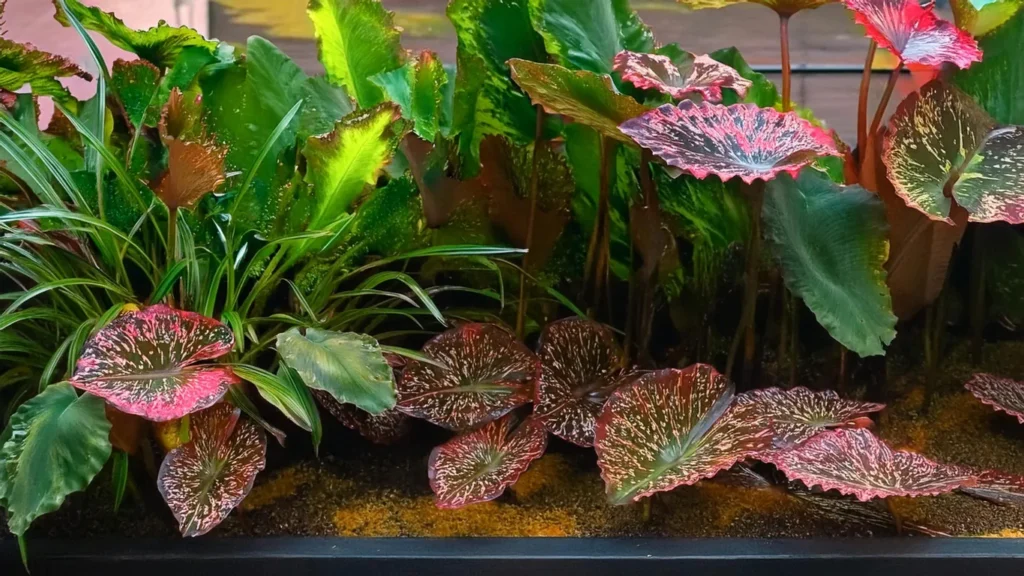
The Native Habitat Of The Tiger Lotus
Nymphaea Tiger Lotus is naturally found in Africa’s native habitats, where it has adapted to thrive in specific environmental conditions.
This aquatic plant prefers warm climates and requires abundant sunlight to grow and bloom.
It can be found in rivers, lakes, and ponds with shallow waters, where it takes root in mud or sandy substrates.
The native habitat of the Tiger Lotus provides it with the ideal conditions for healthy growth and development.
Physical Characteristics
- Leaves: The leaves of Nymphaea Tiger Lotus are typically large, round, and heart-shaped, with a diameter ranging from a few inches to several inches. They emerge from a central rhizome and float on the water’s surface or extend above it, depending on the plant’s growth stage and environmental conditions.
- Coloration: The leaves exhibit a striking coloration that varies depending on the cultivar and environmental factors. In general, they feature shades of green, red, or brown, often with mottled or marbled patterns. Young leaves may appear green while mature leaves develop deeper hues of red or brown, especially under high light intensity.
- Leaf Texture: The surface of Nymphaea Tiger Lotus leaves is often smooth and glossy, contributing to their attractive appearance. However, some variations may exhibit slightly textured or wrinkled surfaces.
- Stems and Rhizome: Nymphaea Tiger Lotus plants possess a thick, horizontal rhizome from which leaves and roots emerge. The rhizome may be partially buried in the substrate or left exposed, depending on the plant’s growth habit and care requirements. From the rhizome, long, slender stems extend upward, supporting the leaves.
Lighting Needs For Nymphaea Tiger Lotus
- Adequate lighting is essential for the healthy growth of Nymphaea Tiger Lotus. This plant requires moderate to high levels of light to support photosynthesis and promote vibrant leaf coloration. Utilizing full-spectrum lighting, such as LED or fluorescent lights, and providing a suitable photoperiod will help meet the plant’s lighting needs.
- Proper lighting plays a crucial role in the overall health and development of Nymphaea Tiger Lotus. The intensity and duration of light exposure directly impact the plant’s ability to carry out photosynthesis, a vital process for energy production. With sufficient light, the plant’s growth may be stunted, and the leaves may retain their vibrant coloration.
- LED or fluorescent lights are highly recommended to provide the necessary light spectrum for Nymphaea Tiger Lotus. These lights emit the full range of wavelengths required for optimal photosynthesis, ensuring the plant receives the energy needed to thrive. Additionally, LED lights are energy-efficient and long-lasting, making them a popular choice among aquatic plant enthusiasts.
- In addition to selecting the right lighting equipment, it is important to establish a suitable photoperiod for Nymphaea Tiger Lotus. This refers to the duration of light exposure the plant receives each day. A typical photoperiod for aquatic plants is around 10 to 12 hours of light, followed by 12 to 14 hours of darkness. This mimics the natural lighting conditions found in their native habitat.
- Monitoring the light intensity and duration is crucial, as excessive exposure to light can lead to algae growth, while inadequate light can hinder the plant’s growth and development. Striking a balance and providing consistent lighting conditions will help ensure the optimal health and visual appeal of Nymphaea Tiger Lotus in your freshwater aquarium or aquatic garden.
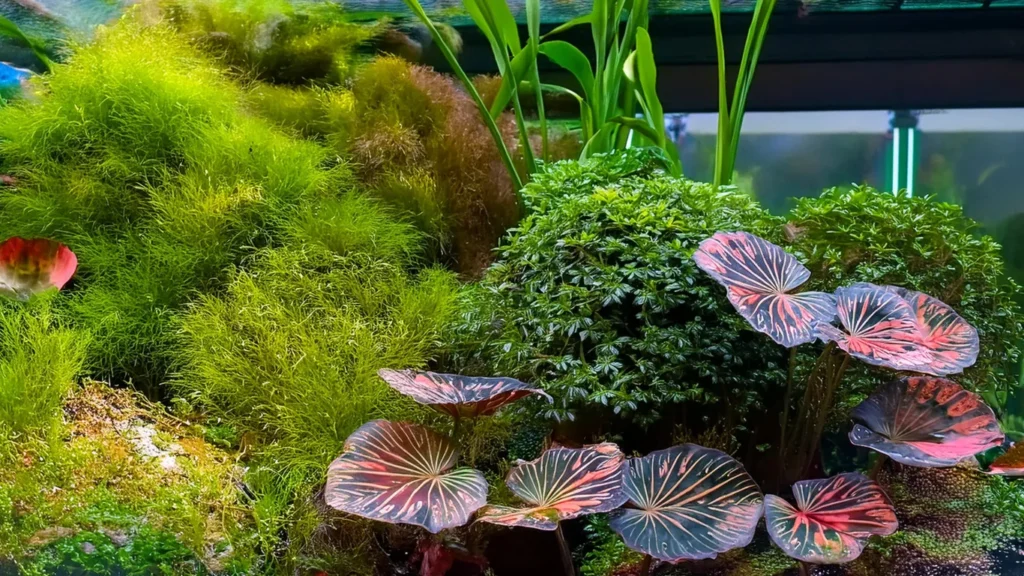
Temperature Parameters
For robust growth, Nymphaea Tiger Lotus typically thrives within a temperature range of 72-82°F (22-28°C).
This range mimics its native tropical habitats and promotes healthy development.
Consistent temperature maintenance within this range helps ensure optimal growth, leaf coloration, and overall plant vigor.
Avoiding significant fluctuations in temperature is also important to prevent stress and maintain plant health.
RELATED: A Comprehensive Guide To Cultivation And Care Of Micranthemum Umbrosum (Baby Tears)
Optimal Water Condition
- pH Levels: Nymphaea Tiger Lotus plants thrive in slightly acidic to neutral water conditions. Maintaining a pH range of 6.5 to 7.5 is optimal for their growth. This pH range mimics the natural conditions of their native habitats and ensures that essential nutrients are readily available for uptake.
- Water Hardness: These plants prefer water with a moderate hardness level. Aim for a general hardness (GH) of 4 to 10 degrees dGH. Maintaining appropriate water hardness helps prevent nutrient deficiencies and ensures that the plants can uptake essential minerals effectively.
- Water Quality: Clean and well-aerated water is essential for the health and growth of Nymphaea Tiger Lotus. Adequate water circulation and oxygenation prevent stagnation and create a favorable environment for plant growth. Regular removal of debris and organic matter from the water helps prevent the accumulation of toxins and maintains water clarity.
- Water Changes: Regular water changes are crucial for maintaining water quality in the aquarium. Partial water changes help remove accumulated pollutants, replenish essential minerals, and maintain stable water parameters. Aim for weekly water changes of around 20-30% to keep the aquarium environment clean and conducive to plant growth.
Substrate Requirement
- Nutrient-Rich Substrate: Nymphaea Tiger Lotus plants benefit from a nutrient-rich substrate that provides essential nutrients for their root development and overall growth. Use a high-quality aquarium soil or substrate specifically designed for planted tanks. These substrates typically contain a rich blend of organic matter, clay, and essential nutrients like nitrogen, phosphorus, and potassium.
- Depth: Provide a substrate layer with sufficient depth to accommodate the plant’s root system. Aim for a depth of at least 2 to 3 inches (5 to 7.5 centimeters) to allow ample space for root growth and anchorage. Deeper substrates also promote stability for the plants and help prevent uprooting.
- Fine Gravel or Sand: Nymphaea Tiger Lotus plants prefer substrates with a fine texture, such as fine gravel or sand. These substrates allow for proper root penetration and anchorage while also facilitating nutrient uptake. Avoid coarse substrates that may damage delicate roots or impede nutrient absorption.

Placement Option
- Foreground or Midground: Depending on the size of your tank and the variety of Tiger Lotus you have, you can place them in the foreground or midground areas. Smaller varieties like the dwarf Tiger Lotus (Nymphaea lotus var. ‘Red’) are suitable for the foreground, while larger varieties may be better suited for the midground.
- Open Space: Nymphaea Tiger Lotus plants appreciate ample space to spread their leaves and display their vibrant colors. Ensure that there is enough open space around the plant to allow its leaves to fully unfurl without obstruction. Avoid overcrowding the area with other plants or decorations.
- Centerpiece: Due to their striking appearance and unique leaf shapes, Nymphaea Tiger Lotus plants make excellent centerpiece specimens. Consider placing them in the center of your aquarium to create a focal point that draws attention and adds visual interest to the aquascape.
- Near Substrate: Plant Nymphaea Tiger Lotus bulbs directly into the substrate to ensure they receive adequate nutrients and anchorage. Planting them slightly deeper in the substrate can help anchor them securely and prevent them from floating or becoming uprooted.
RELATED: A Comprehensive Guide To Growth And Maintenance Of Lilaeopsis Basiliensis
Recommended Tank Size
- Consider Tank Size: Choose a tank with a capacity of at least 10 gallons or more, depending on the variety of Nymphaea Tiger Lotus and its growth requirements.
- Space Requirements: Ensure the tank has sufficient space for the plant to spread its leaves and roots comfortably. Larger tanks allow for better growth and development.
- Variety Consideration: Different varieties of Tiger Lotus may have varying space requirements. Research the specific variety you have and adjust tank size accordingly.
- Room for Growth: Select a tank size that accommodates the mature size of the plant. Tiger Lotus can grow quite large, so providing ample space prevents overcrowding and ensures optimal growth.
- Aquascape Design: Consider the overall aquascape design and layout when choosing the tank size. Larger tanks offer more flexibility in designing a visually appealing setup.
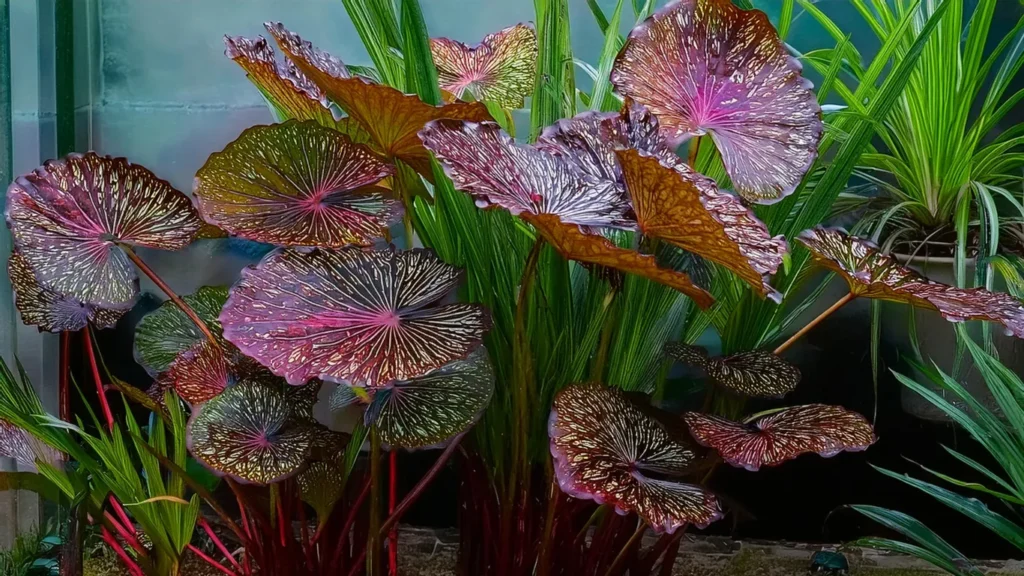
Selecting Compatible Aquatic Plants And Fish
When choosing aquatic plants to accompany Nymphaea Tiger Lotus, opt for species that have similar care requirements and will thrive in the same environmental conditions.
Here are some popular aquatic plants that are compatible with Tiger Lotus:
- Anubias
- Java Fern
- Vallisneria
- Cryptocoryne
- Amazon Sword
These plants not only complement the beauty of Tiger Lotus but also contribute to a healthy and balanced ecosystem.
It is also essential to consider the compatibility of fish species when integrating Tiger Lotus. Choosing fish that are compatible with the plant’s growth requirements and behavior will help maintain a peaceful and thriving aquarium.
Some fish species that are compatible with Tiger Lotus include:
- Betta fish
- Tetras
- Gouramis
- Corydoras catfish
- Rasboras
These fish species coexist well with Tiger Lotus and add to the natural beauty of the aquarium.

Nutritional Needs
- Macronutrients: Tiger Lotus requires nitrogen (N), phosphorus (P), and potassium (K) as primary macronutrients. These are crucial for overall growth, leaf development, and root establishment.
- Micronutrients: Additionally, it needs micronutrients like iron (Fe), manganese (Mn), zinc (Zn), copper (Cu), and others in smaller quantities. These micronutrients play vital roles in enzymatic functions, photosynthesis, and overall plant health.
- Carbon Source: CO2 supplementation can enhance growth and coloration in Tiger Lotus. While it can grow in low-tech setups without added CO2, providing a carbon source such as liquid carbon or injected CO2 can promote healthier growth and vibrant colors.
- Fertilization: Regular fertilization with a balanced aquarium fertilizer or root tabs can help meet the plant’s nutritional needs. Liquid fertilizers can be added directly to the water column, while root tabs can be buried in the substrate to provide nutrients directly to the roots.
- Lighting and Photosynthesis: Adequate lighting is essential for Tiger Lotus to carry out photosynthesis effectively. Ensure the tank receives moderate to high-intensity lighting for at least 8-10 hours a day to support healthy growth.
Nymphaea Tiger Lotus Cultivation Tips
- Lighting: Provide moderate to high-intensity lighting for 8-10 hours daily to support robust growth and vibrant coloration. Ensure the light reaches all parts of the tank, including the substrate where the Tiger Lotus is planted.
- Substrate: Use a nutrient-rich substrate like aquatic soil or nutrient-rich gravel to anchor the Tiger Lotus. A nutrient-rich substrate will provide essential nutrients to the plant’s roots and promote healthy growth.
- Water Parameters: Maintain stable water parameters within the following ranges: pH: 6.5-7.5, temperature: 72-82°F (22-28°C), and water hardness: 3-8 dKH. Avoid extreme fluctuations in water parameters, as they can stress the plant.
- Nutrients: Ensure the plant receives essential macronutrients (NPK) and micronutrients. Use a balanced liquid fertilizer or root tabs to provide nutrients to the plant. Supplement with CO2 if possible, as carbon supplementation can enhance growth and coloration.
Plant Propagation Tips
- Rhizome Division: As Tiger Lotus plants mature, they develop rhizomes that produce new shoots. To propagate, carefully separate these daughter plants from the parent rhizome using sharp scissors or a knife. Ensure each new plantlet has its own portion of the rhizome and roots attached.
- Leaf Cuttings: Trim healthy leaves from the parent plant, ensuring each cutting has a portion of the stem attached. Plant these cuttings in the substrate, burying the stem portion to encourage root growth. With time, new roots will develop from the buried stem, and the cutting will establish itself as a new plant.
- Tuber Division: If your Tiger Lotus has tubers, you can divide them to propagate new plants. Carefully separate the tubers into sections, ensuring each section has viable growing points or buds. Plant these tuber sections in the substrate, burying them slightly, and they will develop into new plants.
- Offshoots: Sometimes, Tiger Lotus plants produce offshoots or runners with miniature plantlets along their stems. These offshoots can be gently detached from the parent plant and replanted in the substrate. Ensure each offshoot has some roots attached to facilitate establishment in the substrate.
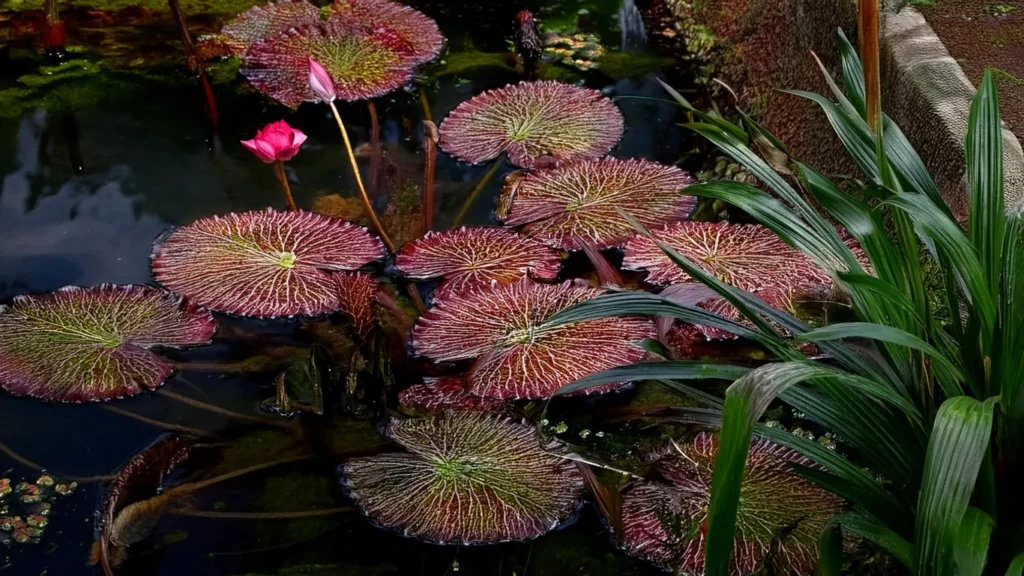
Benefits Of Planting Nymphaea Tiger Lotus
- Aesthetic Appeal: With its vibrant colors and unique leaf shapes, Nymphaea Tiger Lotus adds visual interest to aquariums and ponds, enhancing their beauty.
- Natural Habitat Simulation: Tiger Lotus creates a naturalistic aquatic environment, mimicking the appearance of tropical water bodies where these plants typically grow.
- Oxygenation: Like other aquatic plants, Tiger Lotus contributes to oxygenation by photosynthesis, helping to maintain healthy oxygen levels for fish and other aquatic organisms.
- Water Filtration: The dense foliage of Tiger Lotus plants provides shelter and breeding grounds for small aquatic creatures while also assisting in water filtration by absorbing nutrients and organic waste.
Pest And Disease Management
- Monitor the plant regularly for signs of pests, such as aphids, snails, or algae, and take immediate action if an infestation is detected.
- Remove any dead or decaying plant material from the aquarium to prevent the growth of harmful bacteria or fungi.
- Ensure proper water quality by regularly testing and maintaining appropriate pH, temperature, and nutrient levels.
- Introduce natural predators, such as certain fish species or aquatic invertebrates, that can help control pest populations.
- If necessary, treat the plant with appropriate aquatic-safe pest control products, following the manufacturer’s instructions carefully.
| Pest/Disease | Symptoms | Prevention and Treatment |
| Aphids | Distorted or discolored leaves, sticky residue on leaves | Remove pests manually, use organic insecticides |
| Snails | Bite marks on leaves, slimy trails | Handpick snails, introduce snail-eating fish or invertebrates |
| Algae | Greenish, slimy growth on leaves, glass, or substrate | Maintain proper lighting and nutrient balance, use algae control methods |
| Fungal Infections | Yellow or brown spots, rotting leaves or stems | Remove infected plant parts, improve water circulation, treat with antifungal agents |
Conclusion
Nymphaea Tiger Lotus is a captivating and elegant aquatic plant that has the power to transform any freshwater aquarium or aquatic garden into a mesmerizing oasis.
By providing the proper care and attention to this beautiful plant, you can create a thriving environment that showcases its natural beauty and adds a touch of elegance to your space.
From understanding the importance of proper planting techniques to ensuring the right nutrient balance and lighting conditions, we have explored the key factors contributing to Nymphaea Tiger Lotus’s successful cultivation.
By following these guidelines and maintaining regular maintenance, you can enjoy the vibrant foliage and stunning blossoms of this aquatic plant for years to come.
Frequently Asked Questions
What Are The Nutrient Requirements For Nymphaea Tiger Lotus?
Assessing and maintaining optimal water parameters, including pH, temperature, and nitrogen levels, is crucial for the health and growth of Tiger Lotus.
The choice of substrates, such as nutrient-rich soil or gravel, also plays a vital role in providing necessary nutrients and anchoring roots.
Regular fertilization with aquatic plant fertilizers and supplements can further enhance growth and vibrancy.
What Are The Lighting Needs For Nymphaea Tiger Lotus?
Nymphaea Tiger Lotus requires moderate to high levels of light for photosynthesis and vibrant leaf coloration.
Full-spectrum lighting, such as LED or fluorescent lights, and a suitable photoperiod will help meet the plant’s lighting needs.
How Can I Propagate Nymphaea Tiger Lotus?
Tiger Lotus can be propagated through rhizome division, seed germination, and tissue culture.
Successful cultivation and propagation involve selecting healthy parent plants, preparing propagation materials, and providing ideal environmental conditions for growth.
How Can I Integrate Tiger Lotus Into A Freshwater Aquarium?
When integrating Tiger Lotus into an aquarium, consider the compatibility of other aquatic plants and fish species.
Select plants and fish with similar care requirements and that do not compete for resources, contributing to a harmonious and balanced ecosystem.
What Maintenance Should I Perform For Nymphaea Tiger Lotus?
Regular pruning helps control growth and prevent overcrowding, ensuring adequate light and nutrients for Tiger Lotus.
Implementing effective pest and disease management strategies, maintaining proper water quality, and treating infestations promptly will help keep the plant in optimal condition.
- Unveiling The Wonders Of Riccia Fluitans In Aquascapes - August 7, 2024
- Vallisneria Gigantea Var. Guide To Care And Cultivation At Home - July 31, 2024
- Vesicularia Dubyana Care & Growth Guide Tips For Beginner Gardeners - July 30, 2024
